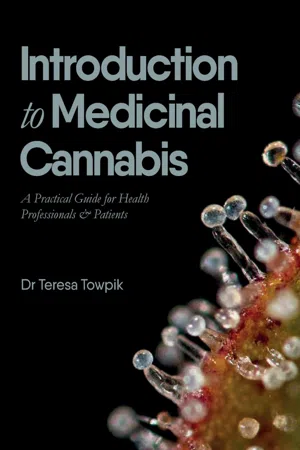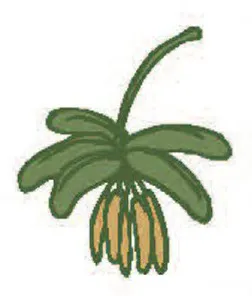
eBook - ePub
Introduction to Medicinal Cannabis
A Practical Guide for Health Professionals and Patients
- English
- ePUB (mobile friendly)
- Available on iOS & Android
eBook - ePub
Introduction to Medicinal Cannabis
A Practical Guide for Health Professionals and Patients
About this book
This book is designed to be a comprehensive introduction to medicinal cannabis for health professionals as well as patients wanting to discover the therapeutical benefits of the cannabis plant.
With this book you'll learn:
- Dr Towpik's personal experience in prescribing medicinal cannabis
- Cannabis plant, its classification, main components and history
- Endocannabinoid system and how it works in the human body
- Endocannabinoid deficiency syndrome theory
- Pharmacology and properties of THC, CBD, minor cannabinoids, terpenes and flavonoids
- Various clinical applications, current evidence and mechanisms of action
- Patients care, various treatment considerations, dosing, monitoring, application process in Australia
- Follow up patient management and monitoring
In text references, allowing the reader to start their own research and further deepen the knowledge about medicinal cannabis
Frequently asked questions
Yes, you can cancel anytime from the Subscription tab in your account settings on the Perlego website. Your subscription will stay active until the end of your current billing period. Learn how to cancel your subscription.
At the moment all of our mobile-responsive ePub books are available to download via the app. Most of our PDFs are also available to download and we're working on making the final remaining ones downloadable now. Learn more here.
Perlego offers two plans: Essential and Complete
- Essential is ideal for learners and professionals who enjoy exploring a wide range of subjects. Access the Essential Library with 800,000+ trusted titles and best-sellers across business, personal growth, and the humanities. Includes unlimited reading time and Standard Read Aloud voice.
- Complete: Perfect for advanced learners and researchers needing full, unrestricted access. Unlock 1.4M+ books across hundreds of subjects, including academic and specialized titles. The Complete Plan also includes advanced features like Premium Read Aloud and Research Assistant.
We are an online textbook subscription service, where you can get access to an entire online library for less than the price of a single book per month. With over 1 million books across 1000+ topics, we’ve got you covered! Learn more here.
Look out for the read-aloud symbol on your next book to see if you can listen to it. The read-aloud tool reads text aloud for you, highlighting the text as it is being read. You can pause it, speed it up and slow it down. Learn more here.
Yes! You can use the Perlego app on both iOS or Android devices to read anytime, anywhere — even offline. Perfect for commutes or when you’re on the go.
Please note we cannot support devices running on iOS 13 and Android 7 or earlier. Learn more about using the app.
Please note we cannot support devices running on iOS 13 and Android 7 or earlier. Learn more about using the app.
Yes, you can access Introduction to Medicinal Cannabis by Dr Teresa Towpik in PDF and/or ePUB format, as well as other popular books in Medicine & General Health. We have over one million books available in our catalogue for you to explore.
Information
SECTION 1 |
The Basics
The History of Cannabis

Cannabis has been assisting humans for thousands of years. As one of the first domesticated crops it was used as medicine, food, textile, rope, fish-nets and as a part of spiritual and sacramental practices, with shamans and mystics using it as a means to communicate with the divine.
The cannabis plant is believed to have come to human attention about 12,000 years ago in Central Asia. It was introduced to western medicine in 1841 by a famous Irish physician, Sir William O’Shaughnessy, upon his return from British India.1 While there, O’Shaughnessy researched cannabis and made many cannabis preparations, initially testing them on animals. Later, after establishing their safety, he used them on humans and found them useful in the treatment of rabies, cholera, tetanus and infantile convulsions.
Cannabis was used extensively in the forms of tinctures, pills and extracts until its 20th century prohibition. It was even a part of cough mixtures for children. Queen Victoria used cannabis in the treatment of menstrual cramps. It was prescribed by doctors and prepared by pharmacists. In 1915, famous English physician, Sir William Osler, referred to cannabis as perhaps the best remedy for severe headaches, especially migraines.
Today’s major pharmaceutical companies were some of the original sellers of cannabis. These include Eli Lilly, Parke-Davis (now owned by Pfizer) and Squibb of Bristol-Myers Squibb. Medical marijuana was a huge seller at the turn of the century.
Smoking of cannabis was unknown in developed countries apart from its occasional use in the treatment of asthma. Recreational cannabis smoking became popular in the US after 1910, during an influx of Mexican migrants.

In the early 1920s, several countries, including Mexico, South Africa and Canada, banned cannabis, signalling the beginning of the end of its close relationship with humankind. By 1925, it had been added to the list of drugs prohibited under the League of Nations’ revised International Opium Convention. The Commissioner of the US Treasury Department Bureau of Narcotics, Harry Anslinger, later succeeded in directing both the League of Nations and its successor, the United Nations, to ban cannabis worldwide.
Cannabis was included in the US Pharmacopoeia until 1942 but its branding by Anslinger as “killer weed”, “assassin of youth” and a “gateway drug” had swayed authorities against it.
The world is now aware that cannabis prohibition was a sop to the vested interests of political and business lobbies and had nothing to do with the pharmacological properties of the plant. In fact, the then president of American Medical Association, Dr William Woodward, opposed prohibition, claiming it would stagnate the medicinal use and the scientific research of the plant.
One of the contributing factors to its removal from the US pharmacopoeia register was the advent of single-molecule synthetic drugs. Major pharmaceutical companies began introducing them at the beginning of the 20th century as a reputedly more effective, safe and predictable medicine. They were considered easier to research, patent and sell. Doctors were trained to trust these formulations and to look down at herbal medicine as inferior, unpredictable and basically something of a tonic or placebo.
Cannabis never disappeared, of course, but simply went “underground” - and now, after decades of prohibition for all the wrong reasons, much of the western world is experiencing a cannabis renaissance.
I believe that because of prohibition we have missed out on a lot of scientific research and knowledge around the medicinal use of cannabis. Prohibition led to the creation of the black market, which focused mostly on the narcotic effects of the plant and drove production of high-THC cannabis strains.
In spite of prohibition, some scientific discoveries were still occurring. In 1964 Israeli organic chemist Raphael Mechoulam isolated THC, delta-9-tetrahydeocannabinol, the most famous ingredient in the cannabis plant and best known for its psychoactive effects. However, the psychoactive properties of THC are just part of the story. This molecule is highly therapeutic, as will be explained in following chapters.
The discovery of THC opened the doors to further research and a better understanding of human physiology. In the years following the finding, hundreds of other cannabinoids were discovered. The most widely known, cannabidiol, or CBD, was first isolated by Roger Adams in 1940 and its molecular structure was elucidated by...
Table of contents
- Cover
- Copyright Page
- Title Page
- Table of Contents
- Acknowledgements
- Preface
- My personal experience in prescribing cannabis in Australia
- Section 1 | The Basics
- Section 2 | Pharmacology
- Section 3 | Clinical Applications
- Section 4 | Safety Considerations
- Section 5 | Patient Care
- Section 6 | Delivery Methods
- Conclusion
- References